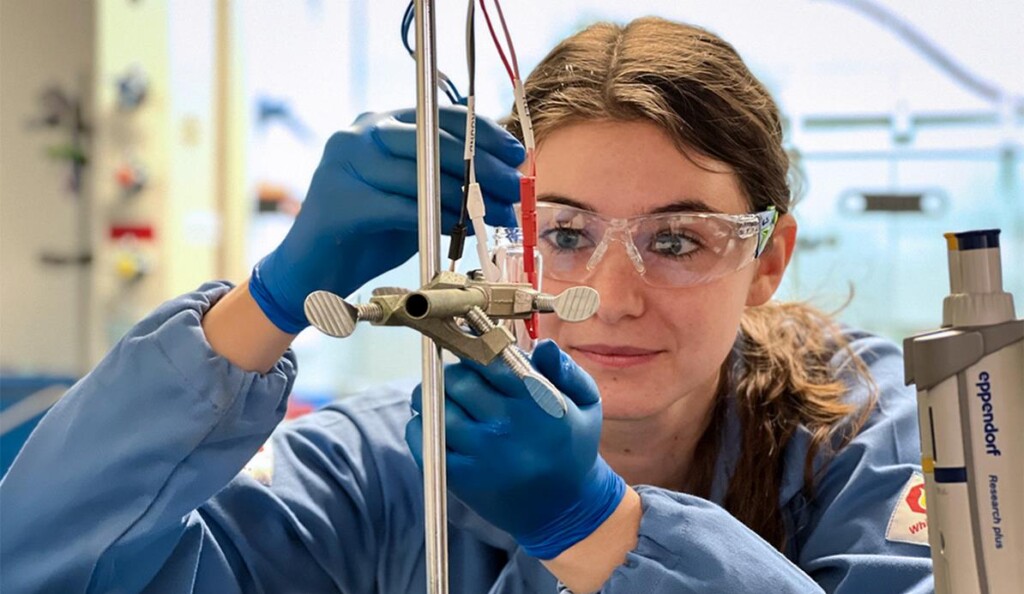 Emily Mahoney, the new paper’s first author, in the lab – courtesy Malapit Lab
Emily Mahoney, the new paper’s first author, in the lab – courtesy Malapit LabA team at Northwestern University has transformed an industrial waste product into a battery for storing sustainable energy.
While many iterations of these batteries are in production or being researched for grid-scale applications, using a waste molecule, in this case, triphenylphosphine oxide, (TPPO) has never been done before.
The batteries used in our phones, devices, and even cars rely on metals like lithium and cobalt, sourced through intensive and sometimes exploitative mining operations. Demand for these critical minerals is expected to skyrocket over the next few decades.
At the same time, thousands of tons of the well-known chemical byproduct TPPO are produced each year by many organic industrial synthesis processes, including the production of vitamin supplements, but it is rendered useless and must be carefully discarded following production.
In a paper published last week in the Journal of the American Chemical Society, a ‘one-pot’ reaction allows chemists to turn TPPO into a usable product with the powerful potential to store energy, opening the door for the future viability of a long-imagined battery type called “redox flow” batteries.
“Battery research has traditionally been dominated by engineers and materials scientists,” said Northwestern chemist and lead author Christian Malapit. “Synthetic chemists can contribute to the field by molecularly engineering an organic waste product into an energy-storing molecule. Our discovery showcases the potential of transforming waste compounds into valuable resources, offering a sustainable pathway for innovation in battery technology.”
The market for redox flow batteries is expected to rise by 15% between 2023 and 2030 to reach a value of $720 million worldwide. Unlike lithium and other solid-state batteries which store energy in electrodes, redox flow batteries use a chemical reaction to pump energy back and forth between electrolytes, where their energy is stored. Though not as efficient at energy storage, redox flow batteries are thought to be much better solutions for energy storage, if not in our cell phones, at the scale of the grid itself.
“Not only can an organic molecule be used, but it can also achieve high-energy density—getting closer to its metal-based competitors—along with high stability,” said Emily Mahoney, a Ph.D. candidate in the Malapit lab and the paper’s first author. “These two parameters are traditionally challenging to optimize together, so being able to show this for a molecule that is waste-derived is particularly exciting.”
To achieve both energy density and stability, the team needed to identify a strategy that allowed electrons to pack tightly together in the solution without losing storage capacity over time. They looked to the past and found a paper from 1968 describing the electrochemistry of phosphine oxides and, according to Mahoney, “ran with it.”
Then, to evaluate the molecule’s resilience as a potential energy-storage agent, the team ran tests using static electrochemical charge and discharge experiments similar to the process of charging a battery, using the battery, and then charging it again, over and over. After 350 cycles, the battery maintained remarkable health, losing negligible capacity over time.
“This is the first instance of utilizing phosphine oxides as the redox-active component in battery research,” Malapit said. “Traditionally, reduced phosphine oxides are highly unstable. Our molecular engineering approach addresses this instability, paving the way for their application in energy storage.”In the meantime, the group hopes other researchers will pick up the idea and begin to work with TPPO to further optimize and improve its potential. Scientists Turn Industrial Waste into Batteries for Storing Renewable Energy
2025-01-16T11:02:00+05:30
